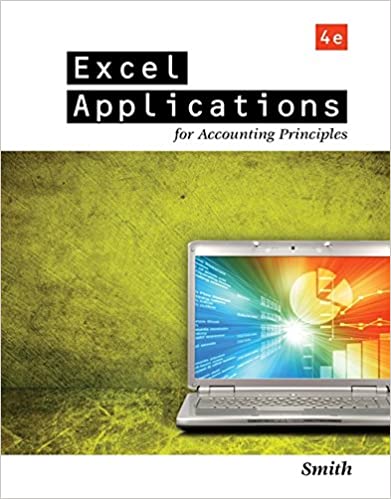
Excel Applications for Accounting Principles 4th Edition by Gaylord Smith
Edition 4ISBN: 978-1111581565
Excel Applications for Accounting Principles 4th Edition by Gaylord Smith
Edition 4ISBN: 978-1111581565 Exercise 3
PROBLEM DATA
Del Rio began Rio Enterprises on January 1 with 200 units of inventory. During the year, 500 additional units were purchased, 500 units were sold, and Del ended the year with 200 units. Del is very satisfied with his first year of business although the cost of replacing his inventory rose continually throughout the year. The 500 units sold for a total of $320,000 and the 500 units purchased to replace them cost $256,000, so his cash account has increased by $64,000. Del is concerned however because he has three obligations yet to meet: taxes, dividends, and his wife. Federal and state income taxes will take 40% of his income. His investors are to receive dividends equal to half of any income after taxes are paid. And finally, Del promised his wife a big trip to Hawaii if she let him quit his job as a professor and start his own business. He promised her he'd "make at least $50,000 after taxes. That will give us $25,000 after paying off the investors."
Del kept fairly good records during the year and knows the specific cost of each inventory unit sold. He has prepared the following table to summarize his purchases and sales.

A quick calculation shows that Rio's net income will be $51,600 using specific costs for the inventory sold. Sales minus cost of goods sold equals gross profit ($320,000 - $234,000 =
$86,000). Taxes to be paid are 40% ($86,000 .4 = $34,400). Subtract taxes from gross profit to get net income ($86,000 - $34,400 = $51,600).
Next, Del calculates his ending cash balance. He currently has $64,000 from his sales less his inventory replacement purchases ($320,000 - $256,000 = $64,000). He needs to pay taxes ($34,400) and dividends to his investors ($51,600 .5 = $25,800). Subtracting $34,400 and $25,800 from $64,000 leaves him with only $3,800. Yikes!
Del is shocked by the computations. He cannot figure out how he will ever explain to his wife that he has net income in excess of $50,000 and yet after paying off the investors he will have only $3,800 to show for it! Del knows you are taking an accounting class and comes to you for help.
REQUIREMENT
Open the file FIFOLIFO from the website for this book at cengagebrain.com. Fill in columns F and G in the Data Section. Then enter all 14 formulas where indicated on the worksheet. Be careful to write FORMULAS 1 through 8 broadly enough to include different sales quantities (i.e., suppose all inventory was sold or no inventory was sold). Enter your name in cell A1. Save the results as FIFOLIFO3. Print the worksheet when done. Also print your formulas. Check figure: FIFO net income (cell E36), $56,400.
Del Rio began Rio Enterprises on January 1 with 200 units of inventory. During the year, 500 additional units were purchased, 500 units were sold, and Del ended the year with 200 units. Del is very satisfied with his first year of business although the cost of replacing his inventory rose continually throughout the year. The 500 units sold for a total of $320,000 and the 500 units purchased to replace them cost $256,000, so his cash account has increased by $64,000. Del is concerned however because he has three obligations yet to meet: taxes, dividends, and his wife. Federal and state income taxes will take 40% of his income. His investors are to receive dividends equal to half of any income after taxes are paid. And finally, Del promised his wife a big trip to Hawaii if she let him quit his job as a professor and start his own business. He promised her he'd "make at least $50,000 after taxes. That will give us $25,000 after paying off the investors."
Del kept fairly good records during the year and knows the specific cost of each inventory unit sold. He has prepared the following table to summarize his purchases and sales.

A quick calculation shows that Rio's net income will be $51,600 using specific costs for the inventory sold. Sales minus cost of goods sold equals gross profit ($320,000 - $234,000 =
$86,000). Taxes to be paid are 40% ($86,000 .4 = $34,400). Subtract taxes from gross profit to get net income ($86,000 - $34,400 = $51,600).
Next, Del calculates his ending cash balance. He currently has $64,000 from his sales less his inventory replacement purchases ($320,000 - $256,000 = $64,000). He needs to pay taxes ($34,400) and dividends to his investors ($51,600 .5 = $25,800). Subtracting $34,400 and $25,800 from $64,000 leaves him with only $3,800. Yikes!
Del is shocked by the computations. He cannot figure out how he will ever explain to his wife that he has net income in excess of $50,000 and yet after paying off the investors he will have only $3,800 to show for it! Del knows you are taking an accounting class and comes to you for help.
REQUIREMENT
Open the file FIFOLIFO from the website for this book at cengagebrain.com. Fill in columns F and G in the Data Section. Then enter all 14 formulas where indicated on the worksheet. Be careful to write FORMULAS 1 through 8 broadly enough to include different sales quantities (i.e., suppose all inventory was sold or no inventory was sold). Enter your name in cell A1. Save the results as FIFOLIFO3. Print the worksheet when done. Also print your formulas. Check figure: FIFO net income (cell E36), $56,400.
Explanation
In the calculations portion of the works...
Excel Applications for Accounting Principles 4th Edition by Gaylord Smith
Why don’t you like this exercise?
Other Minimum 8 character and maximum 255 character
Character 255


